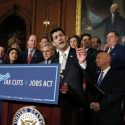Behind The (Revolving) Green Door
Much is made about the “revolving door” between working in government and the private sector, particularly lobbying. People go into government service, leave and make a fortune in the private sector working on the same issues with the same people, then return to government – lather, rinse, repeat. Those stories are usually about the oil or health care industries, mostly because they’re such a huge part of our economy and they’re routinely demonized by liberals and the media. One industry that escapes such scrutiny is “renewable” energy, a left-wing darling. So let’s shine a little light on that today.
The “green” economy is growing, thanks in large part to government “investment,” more commonly known as subsidies. Were it not for the billions of tax dollars pumped into solar, wind, and other “renewable” energy sources, they simply wouldn’t exist. For all the bluster from politicians and activists about them being the way of the future, the future definitely is not now.
They do produce energy, but not consistently nor cost effectively. If they did, so much private capital would pour into them there would be no need for the government subsidies and they wouldn’t be able to keep up with customer demand. As it stands, this is not happening.
Maybe one day the sun will always shine and wind will always blow, and those technologies will find ways to store energy for a literal rainy day. Until then, the power and pocket of government is their only real hope for survival.
Governments across the country are mandating the use of “renewables” as a percentage of their citizen’s energy consumption, federal regulations are making it nearly impossible for proven energy production to grow, and bureaucracies seek to continually expand their power and scope of their reach.
Who better to navigate that leviathan than the people who helped create it?
Enter the revolving green door.
You’ve probably never heard of the Solar Energy Industry Association (SEIA), but their President and CEO, Abigail Ross Hopper, cashed in on her “public service” to run the organization. Serving as Director of the Bureau of Ocean Energy Management at the Department of the Interior and as Director of the Maryland Energy Administration for Democrat Governor Martin O’Malley before that, Hopper helped create the regulatory monster through which she now navigates SEIA. Knowing the procedures (and the staff) is, naturally, a leg up when it comes to accessing favorable government treatment.
Another fellow traveller down the green road is Tom Kiernan, CEO of the American Wind Energy Association. His biography includes having been “Deputy Assistant Administrator of EPA’s Office of Air and Radiation where he assisted in leading the implementation of the 1990 Clean Air Act Amendments.” That being the case, of course, Kiernan has valuable knowledge for navigating a system he helped create.
Another government “success” story is Greg Wetstone, President and CEO of the American Council on Renewable Energy. In a past life, Greg “was Senior Counsel to the House Energy and Commerce Committee, and played an important role in crafting the 1990 Clean Air Act Amendments.” Again, it’s always easier to traverse through a maze you helped design.
None of this would matter were not one of the keys to success for these groups, beyond staffing up with the people who created the regulatory scheme that governs their industry, is favorable treatment in the tax code. As Republicans shift from the failed health reform to tax reform, expect these groups to fight to keep their preferred treatment in the spider web that is the current tax code.
To give one example of how the current tax code favors these industries is the solar investment tax credit. Solar panels are expensive, the current tax code allows consumers to take a 30 percent credit if they buy solar panels for the home or business. In reality, it is a subsidy for the industry, insulating them from market forces that would keep customers away from buying their product.
This credit became law in 2006, and has been set to expire twice but didn’t. It’s now extended through 2021. SEIA touts this preferential treatment on its website. With the prospect of tax reform looming and the opening up of the entire code possible, I reached out to SEIA to see if they planned on lobbying to keep it. They didn’t really answer, saying the credit “has already undergone ‘tax reform.’ In 2015, on a bipartisan basis, Congress extended the ITC and provided a ramp down of the credit by 2021.”
But if history is any guide, all special interest groups, “green” or otherwise, are expected to push hard to maintain their preferential treatment in the massive tax code.
The problem isn’t the solar investment tax credit, or any one credit or subsidy, it’s the entire concept of government manipulation through the tax code – rewarding certain behaviors and punishing others. These manipulations, those who influence and created the labyrinth of government through which we have to navigate our lives, are not just in the industries the media deem worthy of attack.
There are the revolving door in politics, the ones that get media attention and those that are “green.” If you want to “drain the swamp,” you can’t just ignore the ones you like. They all matter.





